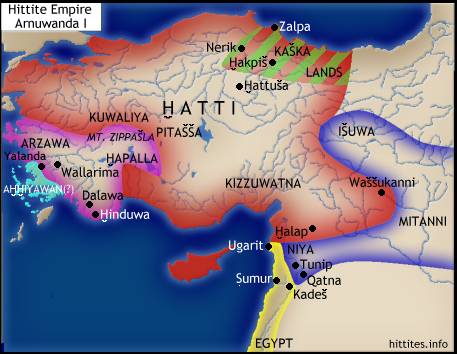| Arnuwanda I King of the Hittites | |
|
He was the Son-in-Law of Tudhaliya II
Possibly the strongest period of Hurrian influence on Hatti (Wilhelm, The Hurrians, p. 30). Hittite princes would take over religious duties previously held by Kizzuwatnian kings. Many Instruction texts were written in the reign of Arnuwanda I, including the HAZANNU Instruction Text and the Instruction Text for the Lords of the Towers. Taken as the antiyant-husband (where the man marries into the woman’s family) of Ašmu-nikal, daughter of Tudhaliya II. He had a son by Ašmu-nikal who bore a Hurrian name, Ašmi-Šarruma. See CAH 2.1 pg. 675. The Anointing of a Successor Trying to decide when in his reign the ruling king would name his successor, the so-called tuhukanti-prince, is somewhat of a challenge when it comes to the Hittites. Examples can be cited for just about any point within a reign. If any pattern can be discerned, it is that the tuhukanti-prince seems to have been named early on in the king’s reign, and if this prince proved himself unworthy at some point later in the reign, he would be deposed from his position in favor of some other son or relative of the king. We have a very fragmentary text in which Arnuwanda names his son Tudhaliya as the tuhukanti-prince. It is useful to note that the tradition of naming a successor and recording the event for posterity continued to be a Hittite custom at this time.
An interesting custom preserved in this fragment is that of anointing, which is reminiscent of later Biblical parallels. The similar Biblical examples would ultimately inspire the anointing of Medieval European rulers, which is how this Near Eastern custom became known to us today. (Cf. Beal) Unfortunately, the text does not indicate when this event occurred within Arnuwanda’s reign. Foreign Relations
Aleppo: Still Hittite. Ahhiyawa: Attarišiya, the Man of Ahhiya,
attacked Madduwatta, a Hittite vassal. A Hittite army repelled the
Ahhiyan army. Later, Attarišiya attacked Alašiya. Madduwatta then took
Alašiya for himself. See The Indictment of Madduwatta. Arzawa: Madduwatta, a Hittite vassal, invaded Arzawa without Arnuwanda’s permission. Madduwatta was defeated by Kupanta-LAMMA, the king of Arzawa, and he fled to the Hittite king. The Hittite king restored Madduwatta to his lands. Later, Attarišiya, the Man of Ahhiya, sought to kill Madduwatta, and Madduwatta fled before his army. Again, a Hittite army saved him by fighting off the Ahhiyan army. Madduwatta, however, decided that his destiny lay elsewhere, and he tricked a Hittite army into an ambush. He then married his daughter to Kupanta-LAMMA. See The Indictment of Madduwatta. Kizzuwatna: Apparently part of the Hittite realm. The Išmirika Protocol has the men of Išmirika swearing an oath to Arnuwanda I and his family. These men are then placed in charge of various cities in Kizzuwatna. The highest official in Kizzuwatna at this time is the BE_L MADGALTI, a provincial governor, not a king. The Išmirika Protocol also indicates that Waššukanni, the usual capital of Mittanni, was located in Kizzuwatna, apparently indicating the extent of Hittite domininion during at least part of this king’s reign. The city of Ura, a port city located on the south central coast, was under Hittite control. Loss of Mittanni? so Oğuz. Revolts in the east might be ascribed to Mitannian backing. |
|
| Some or all info taken from Hittites.info Free JavaScripts provided by The JavaScript Source | |
